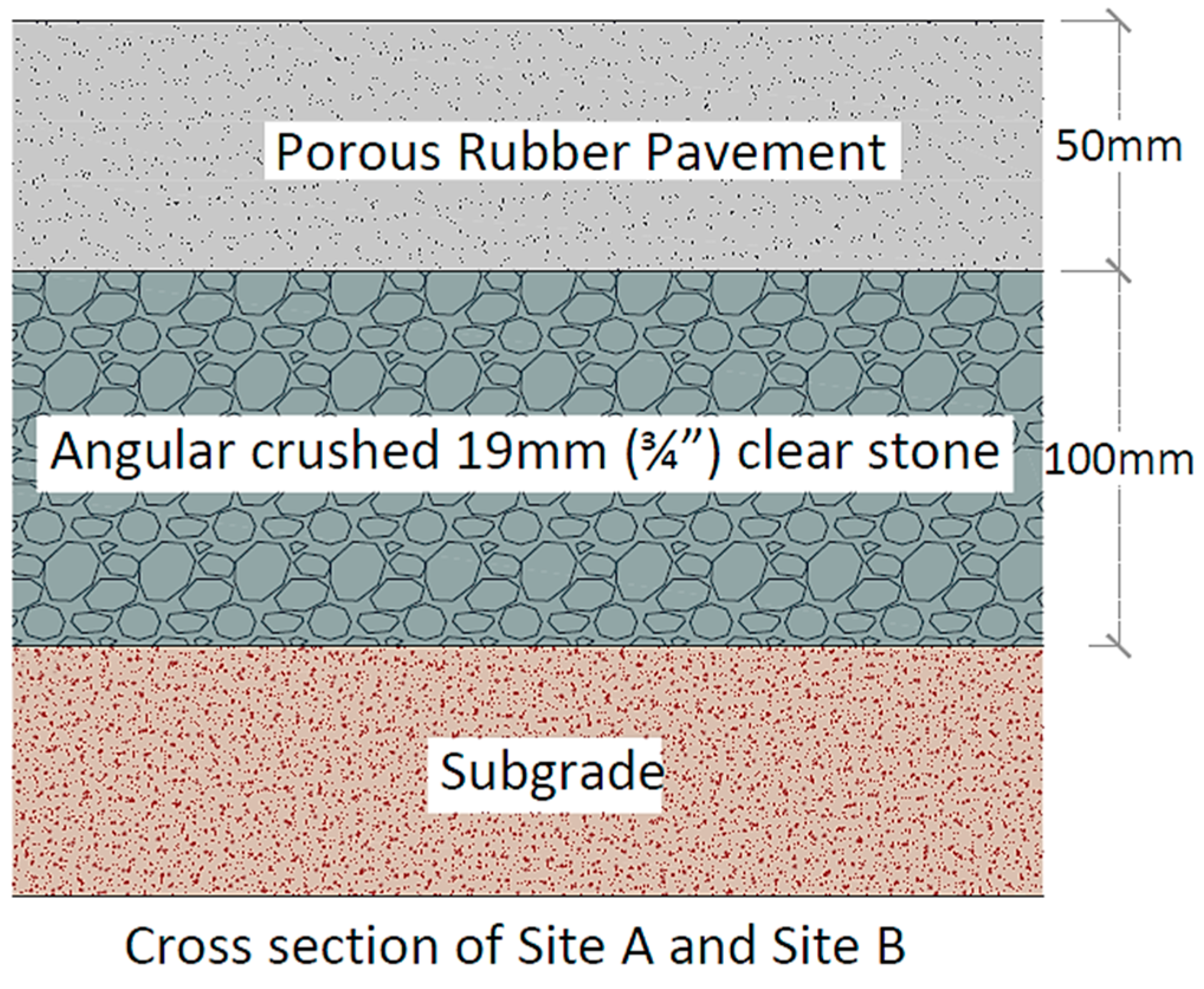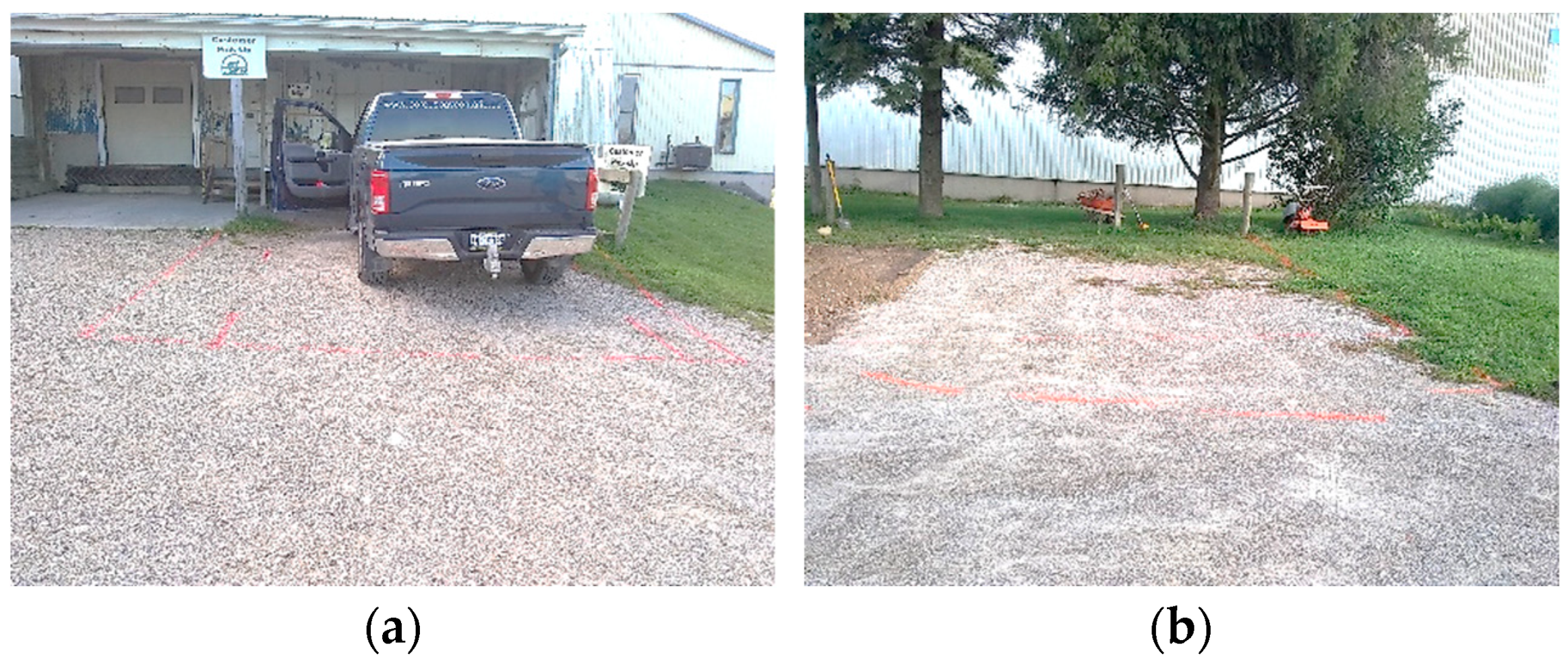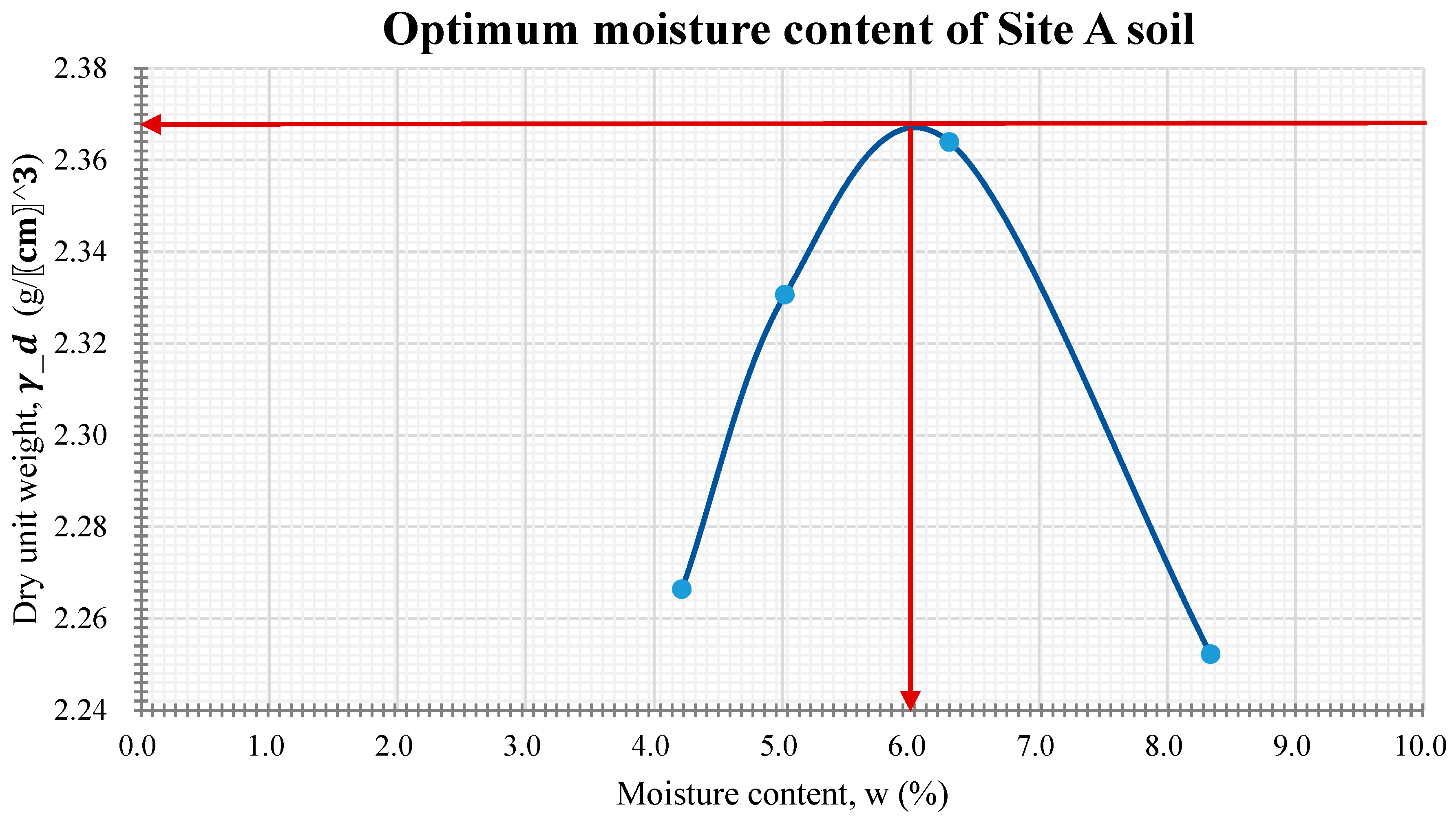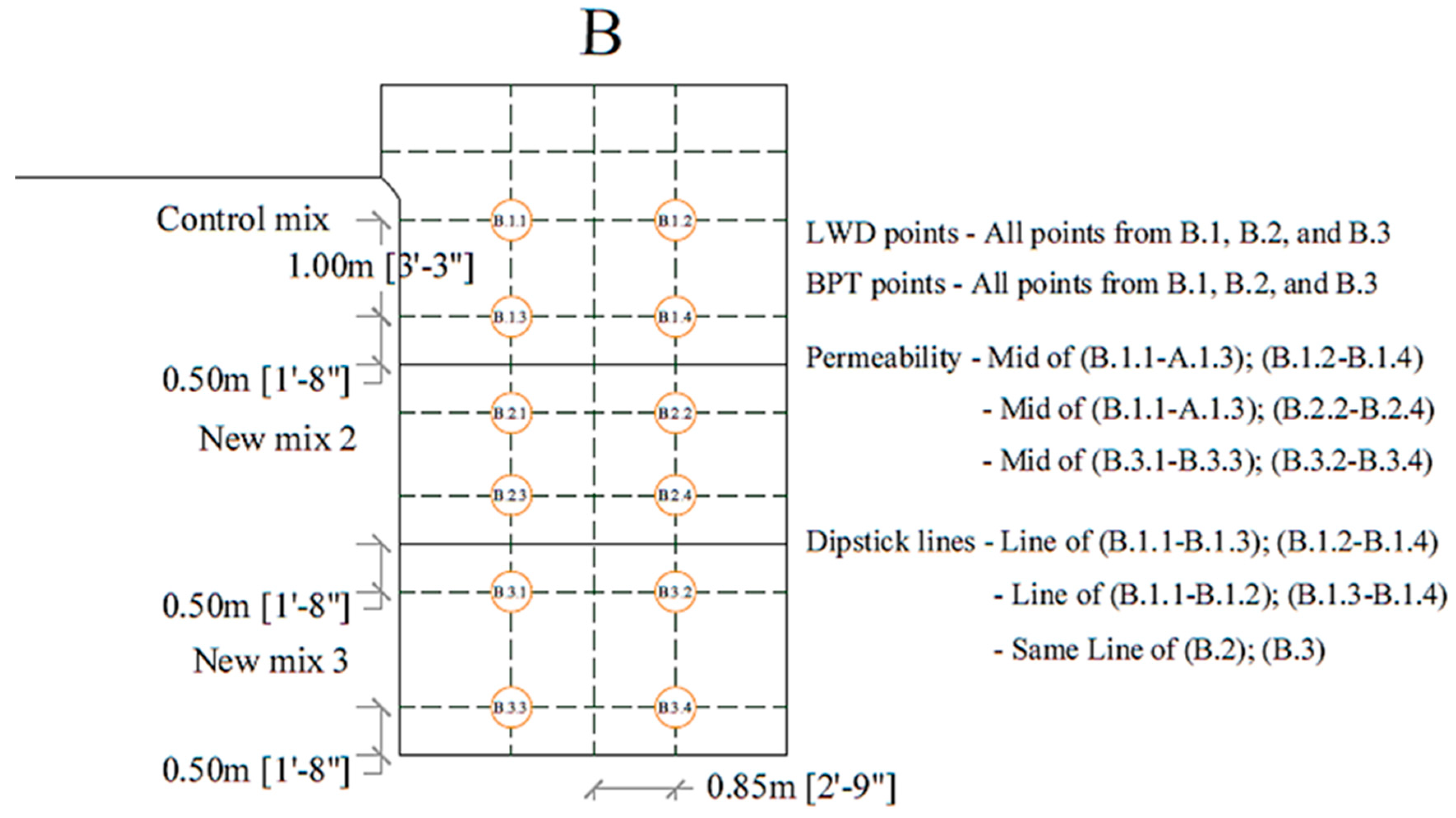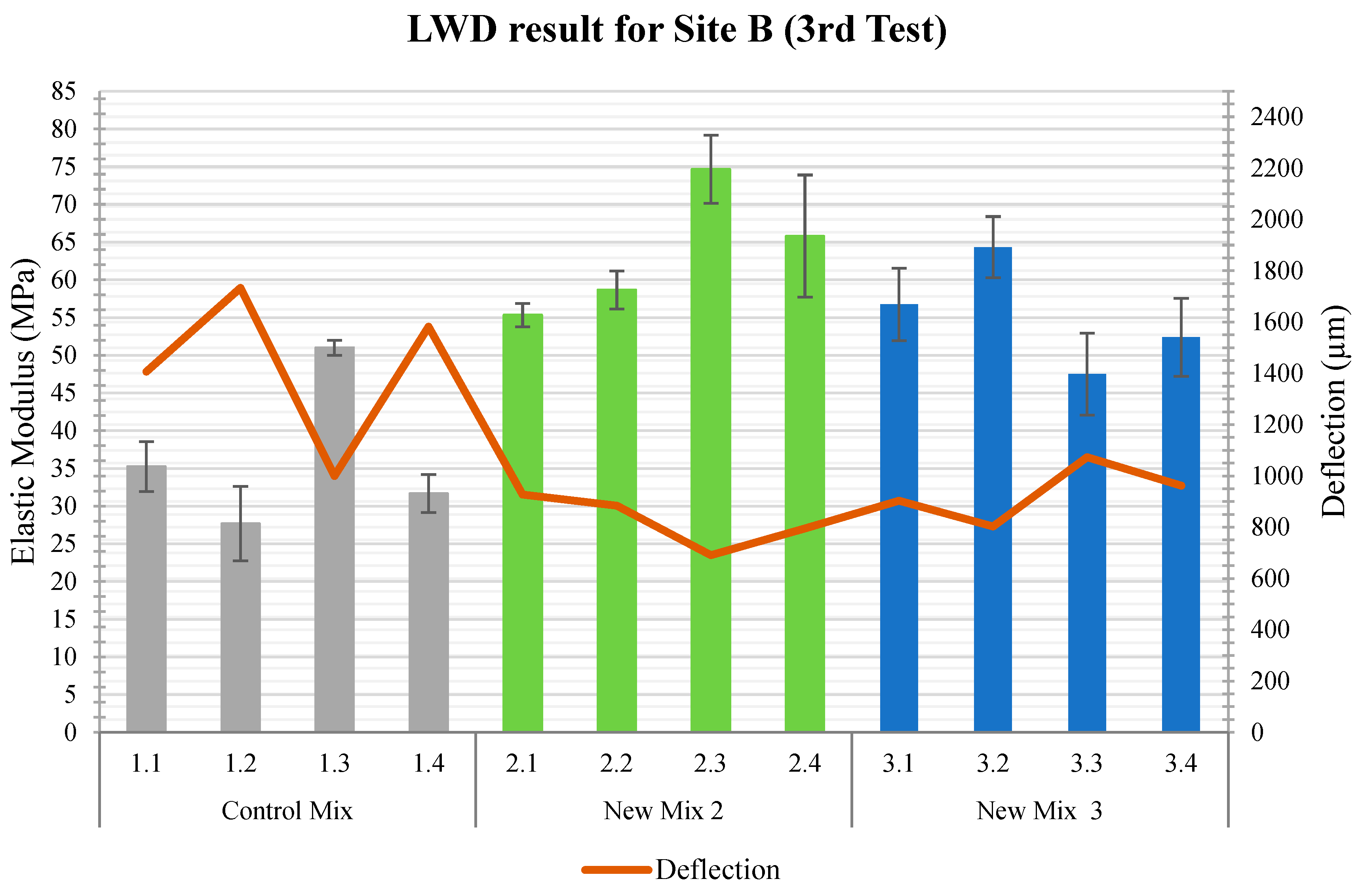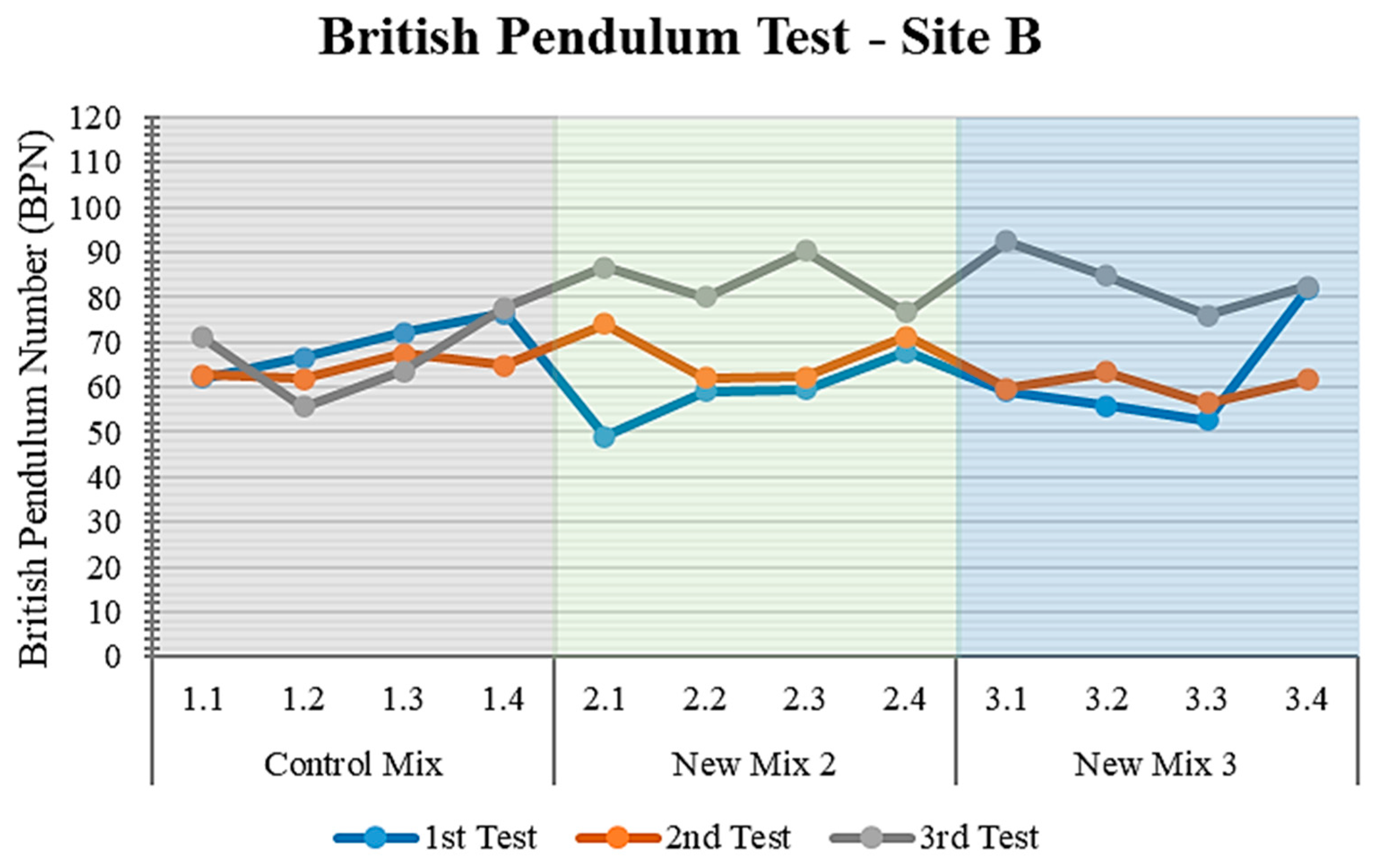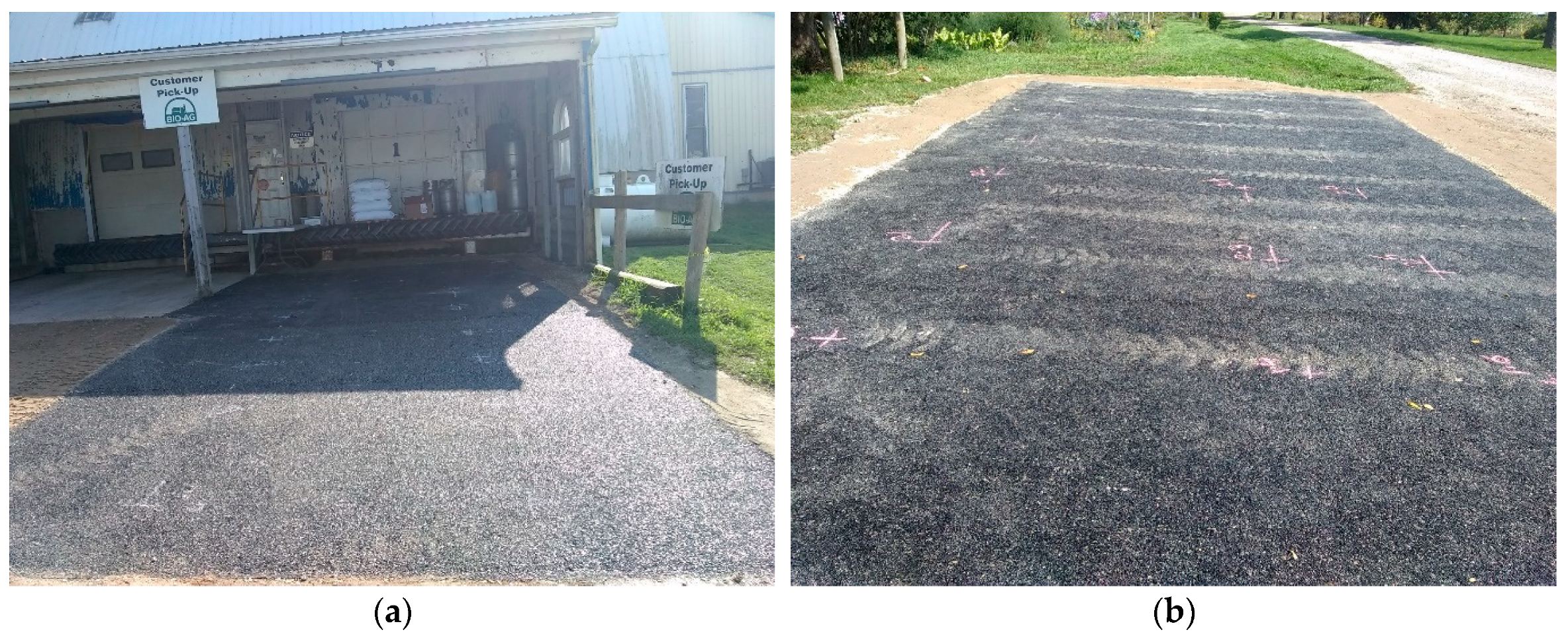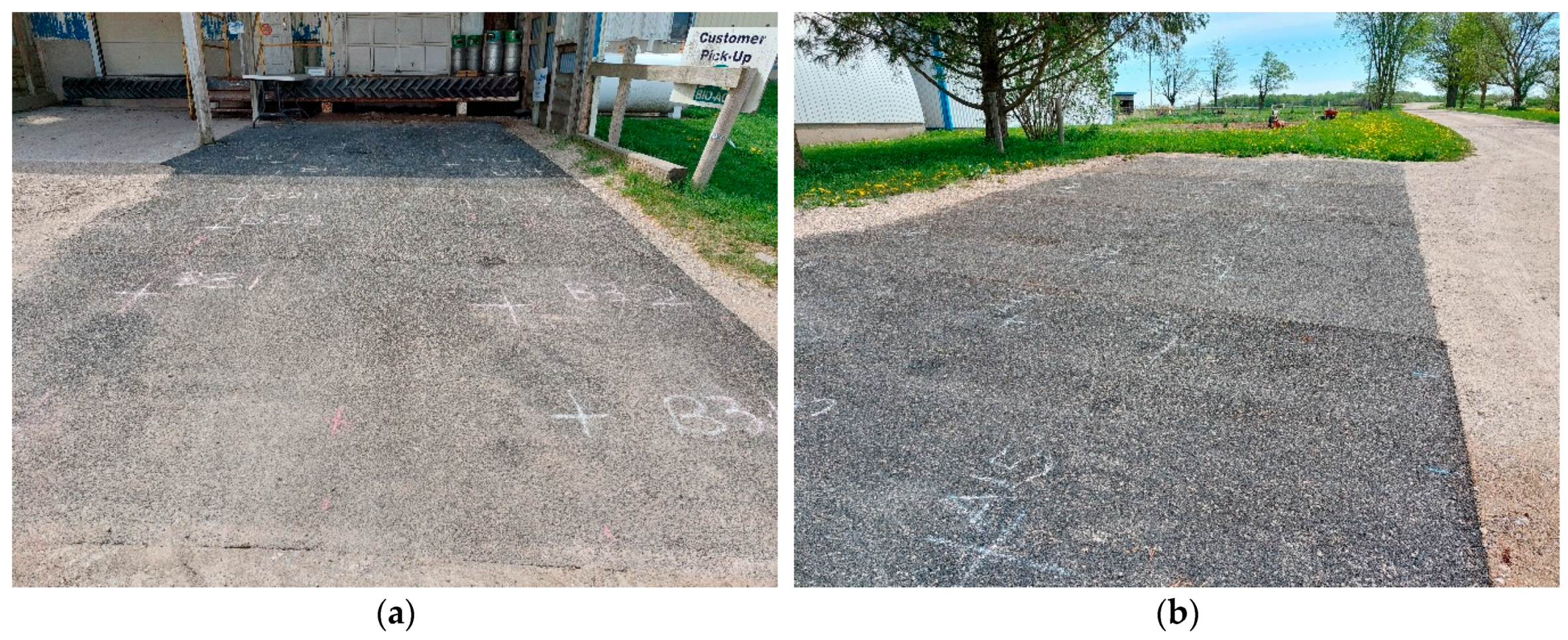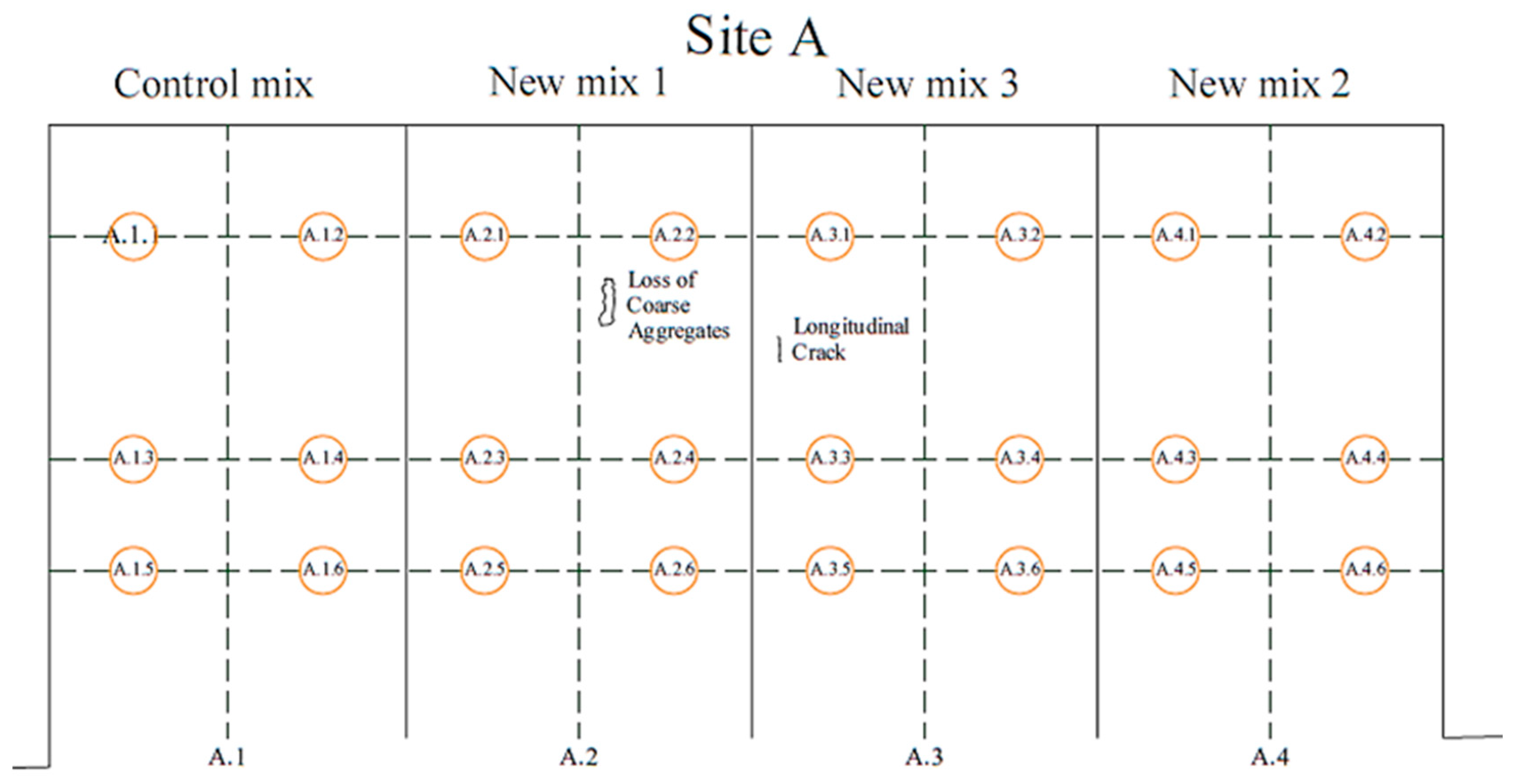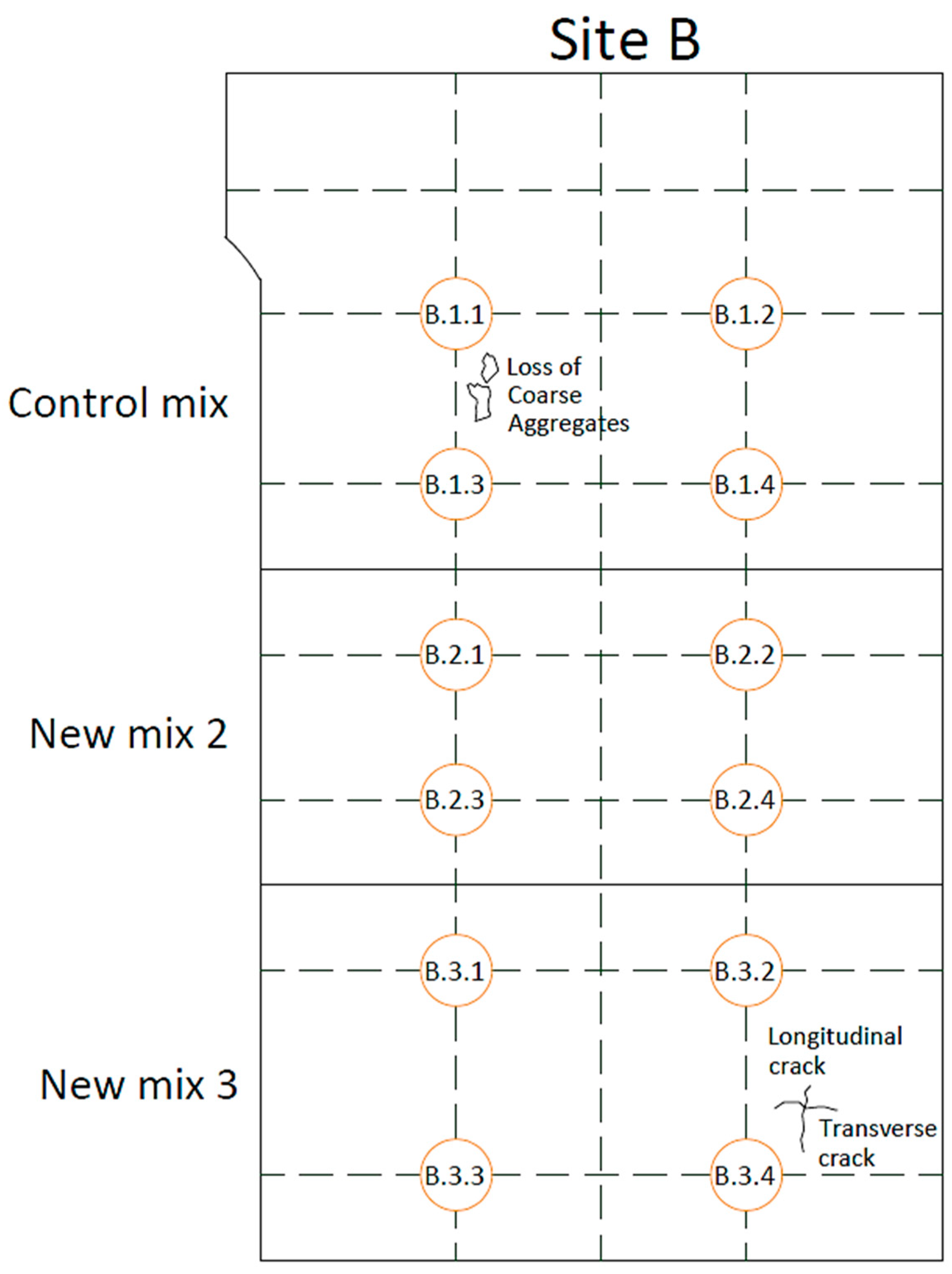Figure 1.
Location of the trial section: bird’s eye view.
Figure 1.
Location of the trial section: bird’s eye view.
Figure 2.
Sites’ view from the entrance.
Figure 2.
Sites’ view from the entrance.
Figure 3.
Site A: before construction with the parked vehicle; (a) view from the side, (b) view from the front.
Figure 3.
Site A: before construction with the parked vehicle; (a) view from the side, (b) view from the front.
Figure 4.
Site B: before construction and heavy vehicle at pickup dock; (a) view from the front, (b) heavy vehicle parked at Site B.
Figure 4.
Site B: before construction and heavy vehicle at pickup dock; (a) view from the front, (b) heavy vehicle parked at Site B.
Figure 7.
Cross section of the trial section.
Figure 7.
Cross section of the trial section.
Figure 8.
Weather station near Site A: (a) different parts of the weather station, (b) location of the weather station.
Figure 8.
Weather station near Site A: (a) different parts of the weather station, (b) location of the weather station.
Figure 9.
Marked on the existing surface layer: (a) Site B marking, (b) Site A marking.
Figure 9.
Marked on the existing surface layer: (a) Site B marking, (b) Site A marking.
Figure 10.
Preparing subgrade with crushed stone: (a) removing surface soil, (b) collecting soil samples, (c) marking of crushed stone layer, (d) compactor to compact crushed stone layer.
Figure 10.
Preparing subgrade with crushed stone: (a) removing surface soil, (b) collecting soil samples, (c) marking of crushed stone layer, (d) compactor to compact crushed stone layer.
Figure 11.
Construction equipment and placement of material: (a) mixer, (b) dumper.
Figure 11.
Construction equipment and placement of material: (a) mixer, (b) dumper.
Figure 12.
Several steps of construction: (a) spreading material on the site, (b) different mixes were poured on different sections, (c) smoothing the surface, (d) water spray on the material, (e) smoothing the surface with a roller, (f) completed section.
Figure 12.
Several steps of construction: (a) spreading material on the site, (b) different mixes were poured on different sections, (c) smoothing the surface, (d) water spray on the material, (e) smoothing the surface with a roller, (f) completed section.
Figure 13.
Preparing sample from trial section mixes: (a) pouring material into the molds, (b) weighing the material for pouring into the mold.
Figure 13.
Preparing sample from trial section mixes: (a) pouring material into the molds, (b) weighing the material for pouring into the mold.
Figure 14.
Laboratory compaction characteristics of the soil: (a) measured material, (b) compacted soil, (c) after demolding the compacted soil.
Figure 14.
Laboratory compaction characteristics of the soil: (a) measured material, (b) compacted soil, (c) after demolding the compacted soil.
Figure 15.
Optimum moisture content of the Site A subgrade soil.
Figure 15.
Optimum moisture content of the Site A subgrade soil.
Figure 16.
Optimum moisture content of Site B subgrade soil.
Figure 16.
Optimum moisture content of Site B subgrade soil.
Figure 17.
CBR test procedure: (a) prepared sample, (b) CBR testing, (c) sample after test.
Figure 17.
CBR test procedure: (a) prepared sample, (b) CBR testing, (c) sample after test.
Figure 18.
Relationship between indirect tensile strength and air voids.
Figure 18.
Relationship between indirect tensile strength and air voids.
Figure 19.
Hamburg curve for different mixes.
Figure 19.
Hamburg curve for different mixes.
Figure 20.
Stripping-related abrasion.
Figure 20.
Stripping-related abrasion.
Figure 21.
Temperature data from the weather station.
Figure 21.
Temperature data from the weather station.
Figure 22.
Precipitation data from the weather station.
Figure 22.
Precipitation data from the weather station.
Figure 23.
Site A detail for testing.
Figure 23.
Site A detail for testing.
Figure 24.
Site B detail for testing.
Figure 24.
Site B detail for testing.
Figure 25.
Elastic modulus and deflection during the 1st test at Site A.
Figure 25.
Elastic modulus and deflection during the 1st test at Site A.
Figure 26.
Elastic modulus and deflection during the 2nd test at Site A.
Figure 26.
Elastic modulus and deflection during the 2nd test at Site A.
Figure 27.
Elastic modulus and deflection during the 3rd test at Site A.
Figure 27.
Elastic modulus and deflection during the 3rd test at Site A.
Figure 28.
Elastic modulus and deflection during the 1st test at Site B.
Figure 28.
Elastic modulus and deflection during the 1st test at Site B.
Figure 29.
Elastic modulus and deflection during the 2nd test at Site B.
Figure 29.
Elastic modulus and deflection during the 2nd test at Site B.
Figure 30.
Elastic modulus and deflection during the 3rd test at Site B.
Figure 30.
Elastic modulus and deflection during the 3rd test at Site B.
Figure 31.
British Pendulum Test for Site A.
Figure 31.
British Pendulum Test for Site A.
Figure 32.
British Pendulum Test for Site B.
Figure 32.
British Pendulum Test for Site B.
Figure 33.
Comparison of rut depth between tests on Site A.
Figure 33.
Comparison of rut depth between tests on Site A.
Figure 34.
Comparison of rut depth between tests on Site B.
Figure 34.
Comparison of rut depth between tests on Site B.
Figure 35.
Site B right after construction.
Figure 35.
Site B right after construction.
Figure 36.
Site A and Site B after two weeks of construction: (a) Site A, (b) Site B.
Figure 36.
Site A and Site B after two weeks of construction: (a) Site A, (b) Site B.
Figure 37.
Site A and Site B after seven months of construction: (a) Site B preparation for testing, (b) Site A preparation for testing.
Figure 37.
Site A and Site B after seven months of construction: (a) Site B preparation for testing, (b) Site A preparation for testing.
Figure 38.
Surface distress evaluation for Site A.
Figure 38.
Surface distress evaluation for Site A.
Figure 39.
Surface distress evaluation for Site B.
Figure 39.
Surface distress evaluation for Site B.
Table 1.
Basic properties of the components.
Table 1.
Basic properties of the components.
| | Rubber Aggregates | Stone Aggregates | Polyurethane Binder |
|---|
| Basic properties | Recycled crumbed tire rubber | Granite aggregates | B1—aromatic binder |
| Size of aggregates | 1.18 to 2.36 mm | 4.75 to 6.75 mm. | |
Table 2.
Mixes used for trial section construction.
Table 2.
Mixes used for trial section construction.
| Mixes with Different Proportions of Components | A—Stone Aggregate, R—Rubber Aggregate, B—Polyurethane Binder | Air Voids |
|---|
| Control Mix | A—45.25%, R—45.25%, B—9.5% | 38–45% |
| New Mix 1 | A—55%, R—37.5%, B—7.5% | Within 24–38% |
| New Mix 2 | A—75%, R—17.5%, B—7.5% |
| New Mix 3 | A—55%, R—33%, B—12% |
Table 3.
Subgrade soil category for Site A and Site B.
Table 3.
Subgrade soil category for Site A and Site B.
| | CBR of Trial Sites |
|---|
| Site | Average CBR | Standard Dev. | Soil Type |
|---|
| Site A | 18.2 | 1.5 | SM |
| Site B | 24.3 | 4.3 | SW |
Table 4.
Indirect tensile strength result.
Table 4.
Indirect tensile strength result.
| Mix Types | Air Voids | Average Air Void | Indirect Tensile Strength (kPa) | Average (kPa) | Standard Deviation |
|---|
| Control Mix | 38 | 38 | 296.0 | 299.3 | 8.86 |
| 39 | 292.5 |
| 38 | 309.3 |
| New Mix 1 | 31 | 31 | 332.8 | 306.1 | 23.11 |
| 31 | 292.7 |
| 32 | 292.8 |
| | 26 | | 571.4 | | |
| New Mix 2 | 18 | 24 | 497.0 | 518.7 | 45.86 |
| | 29 | | 487.7 | | |
| | 23 | | 648.9 | | |
| New Mix 3 | 22 | 23 | 692.9 | 682.4 | 29.69 |
| | 22 | | 705.4 | | |
Table 5.
Tensile Strength Ratio (TSR) after moisture–induced damage.
Table 5.
Tensile Strength Ratio (TSR) after moisture–induced damage.
| Mix | ITS before Conditioning | Standard Deviation | ITS after Conditioning | Standard Deviation | TSR | Standard Deviation |
|---|
| Control Mix | 299.3 | 8.86 | 238.8 | 4.7 | 0.80 | 0.02 |
| New Mix 1 | 306.1 | 23.11 | 224.2 | 8.1 | 0.73 | 0.03 |
| New Mix 2 | 518.7 | 45.86 | 351.4 | 16.2 | 0.68 | 0.03 |
| New Mix 3 | 682.4 | 29.69 | 515.4 | 36.5 | 0.76 | 0.05 |
Table 6.
Hamburg wheel tracking test.
Table 6.
Hamburg wheel tracking test.
| Trial Section Hamburg Wheel Tracking Test |
|---|
| Mixes | Depth 01 (mm) | Depth 02 (mm) | Rutting Average (mm) | Standard Deviation |
|---|
| Control mix | 0.72 | 0.89 | 0.81 | 0.12 |
| New mix 1 | 1.18 | 0.6 | 0.89 | 0.41 |
| New mix 2 | 1.4 | 0.58 | 0.99 | 0.58 |
| New mix 3 | 0.81 | 1.09 | 0.95 | 0.20 |
Table 7.
Stripping-related abrasion in percentage in trial section sample.
Table 7.
Stripping-related abrasion in percentage in trial section sample.
| Mixes | Weight Loss after Rutting Test |
|---|
| Control mix | −0.3% |
| New mix 1 | −0.3% |
| New mix 2 | 0.0% |
| New mix 3 | 0.7% (increased) |
Table 8.
Schedule for field testing.
Table 8.
Schedule for field testing.
| Date | Construction | Testing |
|---|
| 2 October 2021 | Phase 01 | |
| 4 October 2021 | | 1st Testing |
| 5 October 2021 | Phase 02 |
| 7 October 2021 | |
| 23 October 2021 | | 2nd Testing |
| 13 May 2022 | | 3rd Testing |
Table 9.
Elastic modulus and deflection of Site A.
Table 9.
Elastic modulus and deflection of Site A.
| Trial Section—Site A |
|---|
| Mixes | Elastic Modulus (MPa) |
| | 1st test | Standard dev. | 2nd test | Standard dev. | 3rd test | Standard dev. |
| Control Mix | 36 | 12 | 45 | 15 | 39 | 11 |
| New Mix 1 | 32 | 6 | 38 | 10 | 28 | 3 |
| New Mix 3 | 34 | 10 | 34 | 8 | 28 | 2 |
| New Mix 2 | 28 | 3 | 29 | 3 | 23 | 5 |
| Mixes | Deflection (µm) |
| | 1st test | Standard dev. | 2nd test | Standard dev. | 3rd test | Standard dev. |
| Control Mix | 1335 | 309 | 1174 | 374 | 1350 | 356 |
| New Mix 1 | 1530 | 264 | 1342 | 298 | 1771 | 172 |
| New Mix 3 | 1474 | 341 | 1470 | 321 | 1729 | 153 |
| New Mix 2 | 1682 | 182 | 1629 | 175 | 1715 | 775 |
Table 10.
Elastic modulus and deflection at Site B.
Table 10.
Elastic modulus and deflection at Site B.
| Trial Section—Site B |
|---|
| Mixes | Elastic Modulus (MPa) |
| | 1st test | Standard dev. | 2nd test | Standard dev. | 3rd test | Standard dev. |
| Control Mix | 42 | 10 | 38 | 7 | 36 | 10 |
| New Mix 2 | 59 | 15 | 73 | 9 | 64 | 9 |
| New Mix 3 | 41 | 3 | 68 | 6 | 55 | 7 |
| Mixes | Deflection (µm) |
| | 1st test | Standard dev. | 2nd test | Standard dev. | 3rd test | Standard dev. |
| Control Mix | 1265 | 252 | 1307 | 276 | 1430 | 317 |
| New Mix 2 | 967 | 204 | 667 | 76 | 824 | 104 |
| New Mix 3 | 1359 | 119 | 725 | 66 | 935 | 113 |
Table 11.
British Pendulum Test result from Site A.
Table 11.
British Pendulum Test result from Site A.
| Trial Section—Site A |
|---|
| Mixes | British Pendulum Number (BPN) |
|---|
| | 1st Test | Standard dev. | 2nd Test | Standard dev. | 3rd Test | Standard dev. |
|---|
| Control Mix | 73 | 10 | 60 | 4 | 64 | 28 |
| New Mix 1 | 69 | 8 | 55 | 5 | 72 | 9 |
| New Mix 3 | 58 | 6 | 48 | 4 | 45 | 15 |
| New Mix 2 | 60 | 6 | 50 | 3 | 55 | 22 |
Table 12.
British Pendulum Test result from Site B.
Table 12.
British Pendulum Test result from Site B.
| Trial Section—Site B |
|---|
| Mixes | British Pendulum Number (BPN) |
|---|
| | 1st Test | Standard dev. | 2nd Test | Standard dev. | 3rd Test | Standard dev. |
|---|
| Control Mix | 69 | 6 | 64 | 2 | 67 | 9 |
| New Mix 2 | 59 | 8 | 67 | 6 | 83 | 6 |
| New Mix 3 | 62 | 13 | 60 | 3 | 84 | 7 |
Table 13.
Rut depth result from Site A.
Table 13.
Rut depth result from Site A.
| Rut Depth from Dipstick—Site A |
|---|
| Mixes | Avg. Depth of Rut (mm)—1st Test | Avg. Depth of Rut (mm)—2nd Test |
|---|
| Control Mix | −7.7 | −22.5 |
| New Mix 1 | −7.9 | −23.6 |
| New Mix 3 | −7.0 | −22.6 |
| New Mix 2 | −8.7 | −26.0 |
Table 14.
Rut depth result from Site B.
Table 14.
Rut depth result from Site B.
| Rut Depth from Dipstick—Site B |
|---|
| Mixes | Avg. Depth of Rut (mm)—1st Test | Avg. Depth of Rut (mm)—2nd Test |
|---|
| Control Mix | −10.7 | −24.4 |
| New Mix 2 | −6.6 | −19.6 |
| New Mix 3 | −5.8 | −21.5 |
Table 15.
Permeability of Site A.
Table 15.
Permeability of Site A.
| Permeability of Site A |
|---|
| Mix | Average Infiltration (mm/h) | Standard Deviation | Average Infiltration (mm/h) | Standard Deviation | Average Infiltration (mm/h) | Standard Deviation |
|---|
| | 1st Test | 2nd Test | 3rd Test |
|---|
| Control mix | 45,605 | 6845 | 48,428 | 10,956 | 57,715 | 9502 |
| New mix 1 | 44,785 | 2019 | 62,741 | 2313 | 74,805 | 13,139 |
| New mix 3 | 28,368 | 5183 | 24,695 | 7555 | 22,658 | 6639 |
| New mix 2 | 39,608 | 5970 | 45,476 | 4409 | 40,244 | 24,851 |
Table 16.
Permeability of Site B.
Table 16.
Permeability of Site B.
| Permeability of Site B |
|---|
| Mix | Average Infiltration (mm/h) | Standard Deviation | Average Infiltration (mm/h) | Standard Deviation | Average Infiltration (mm/h) | Standard Deviation |
|---|
| | 1st Test | 2nd Test | 3rd Test |
|---|
| Control mix | 39,681 | 3070 | 48,334 | 3808 | 25,468 | 18,009 |
| New mix 2 | 37,698 | 1991 | 50,998 | 3357 | 11,029 | 8394 |
| New mix 3 | 30,469 | 262 | 21,649 | 70 | Clogged | 0 |
Table 17.
Site A distress evaluation.
Table 17.
Site A distress evaluation.
| Site | Distress Manifestation | Distress Type | Severity | Extent | Description |
|---|
| Site A | Surface defects | Loss of Coarse Aggregates | 2 (Slight) | <10% area affected (few) | Noticeable loss of pavement material. |
| Ravelling | 1 (Very slight) | 10 to 20% of surface area (Intermittent) | Barely noticeable loss/lack of pavement materials. |
| Permanent deformation | Rutting | 1 (Very slight) | <10% area affected (few) | Barely noticeable, less than 6 mm. |
| Cracking | Longitudinal crack | 1 (Very slight) | <10% area affected (few) | Single crack width less than 3 mm. Measured length 10 mm. |
Table 18.
Site B distress evaluation.
Table 18.
Site B distress evaluation.
| Site | Distress Manifestation | Distress Type | Severity | Extent | Description |
|---|
| Site B | Surface defects | Loss of Coarse Aggregates | 2 (Slight) | <10% area affected (few) | Noticeable loss of pavement material. |
| Ravelling | 1 (Very slight) | 10 to 20% of surface area (Intermittent) | Barely noticeable loss/lack of pavement materials. |
| Permanent deformation | Rutting | 1 (Very slight) | <10% area affected (few) | Barely noticeable, less than 6 mm. |
| Cracking | Longitudinal crack | 1 (Very slight) | <10% area affected (few) | Single crack width less than 3 mm. Measured length 127 mm. |
| Transverse crack | 1 (Very slight) | <10% area affected (few) | Single crack width less than 3 mm. Measured length 100 mm. |






